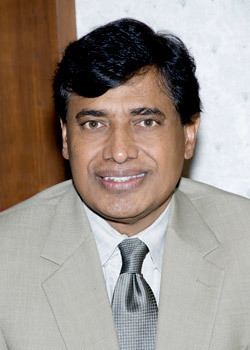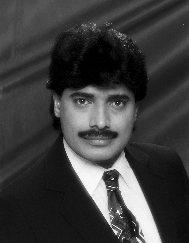Name Periannan Senapathy | Spouse Roopa Senathipathy | |
 | ||
Books Independent birth of organisms Profiles | ||
Periannan Senapathy is a molecular biologist, geneticist, author and entrepreneur. He is the founder, president and chief scientific officer at Genome International Corporation, a biotechnology & bioinformatics firm based in Madison, Wisconsin, which develops next-generation DNA sequencing analysis technologies.
Contents
Senapathy is known for his contributions in the biology of RNA splicing and the structure of eukaryotic genes. An algorithm developed by him, known as Shapiro & Senapathy algorithm (S&S) for predicting the splice sites, exons and genes in any animal or plant, has the ability to discover disease-causing mutations in splice junctions in numerous cancers and non-cancer diseases. The Shapiro - Senapathy algorithm has been implemented in many gene-finding and mutation detection tools, and is being used in major research institutions around the world for uncovering mutations in the splicing regions. It is increasingly used in the Next Generation Sequencing era, as it is widely realized that >60% of all mutations causing diseases or adverse drug reactions in humans and other animals occur within the splicing regions of genes. The S&S algorithm has been cited in ~3,000 publications on finding splicing mutations in thousands of diseases including many different forms of cancer.
Senapathy is also known for offering a new theory on the origin and diversity of life on earth, where he proposes that genomes for eukaryotic life forms could have been directly assembled from a common pool of split genes in prebiotic chemistry. He had authored a book, titled Independent Birth of Organisms in 1994, where he first proposed this theory. He has also published his scientific findings in journals such as Science (journal), Nucleic Acids Research, PNAS among others, and is the author of several patents in the Genomics field.
Biography

Senapathy has a PhD in molecular biology from the Indian Institute of Science, Bangalore, India. He spent ten years in genome research for the National Institutes of Health's Division of Computer Research and Technology in Bethesda, Maryland, (1980–87) and the Biotechnology Center of the University of Wisconsin, Madison (1987–90). Dr. Senapathy founded Genome International in 1992, which owns the domain genome.com.
Notable works
Senapathy conducted genomics and bioinformatics studies based on the idea that prebiotic genetic sequences must have had random characteristics. He had observed that the reading-frame lengths in a random nucleotide sequence follow an exponential distribution, which is exactly found in eukaryotic genome sequences, and suggested the split-gene model. In this model, a selective pressure existed in the most primitive unicellular eukaryotes to generate longer coding sequences from random DNA sequences that were populated with in-frame nonsense codons, and intervened between short reading frames, started to be excised by an already existing spliceosome. This model proposes not only that the sequences excised contained random clusters of in-frame nonsense codons but also that the splice junction signal sequences and the branch point sequence originate from nonsense codons.
From an evolution perspective, Senapathy's research focused on why eukaryotic genes are split into exons and introns and why large genomes such as human and sea urchin contain very long introns and very short exons. Noted evolutionary molecular biologist Colin Blake commented on Senapathy's theory that: "Recent work by Senapathy, when applied to RNA, comprehensively explains the origin of the segregated form of RNA into coding and non-coding regions. It also suggests why a splicing mechanism was developed at the start of primordial evolution. The presence of random sequence was therefore sufficient to create in the primordial ancestor the segregated form of RNA observed in the eukaryotic gene structure.”
Senapathy's research focuses on how all of life's complexity originated directly from the primordial pond, without a need for the origin of the primitive bacterium-like microbe that had to evolve into all organisms on earth through laborious genetic mutations.
Independent Birth of Organisms
Senapathy published a book titled Independent Birth of Organisms in 1994, which proposes that all organisms on earth had originated independently from a chemical pond, thus rejecting common descent The book was a result of his 12 years research in molecular biology.
Andrew Petto, an anthropologist of University of Wisconsin reviewed Senapathy's book saying that Senapathy has some very interesting views about the origins of life, such as his interpretation of the primordial soup theory and that these ideas should be taken seriously by the reader.
Recent literature findings from comparative genomics are showing overwhelmingly that the earliest organisms could have been highly complex and eukaryotic and could have contained complex proteins, which is predicted by Senapathy’s theory.
Gert Korthof, an evolutionary biologist, reviewed Senapathy’s book in detail. Although Korthof rejects Senapathy’s theory, he states that it would not be fair to disprove his theory using current biological knowledge or dogmatically use the theory of evolution to refute his views. In addition, Gert Korthof shows how even theories of the origin of life are fundamentally flawed, such as those in The Origin of Membrane Biogenetics, and its commentary. He also brings out many other errors in the conventional origin of life models, such as the impossible origin of the minimalistic ribosomal RNA sequences which is the foundation for the origin of life, and how the authors try erroneously to overcome this difficulty.
